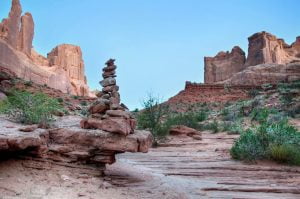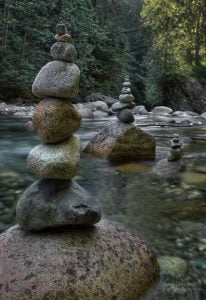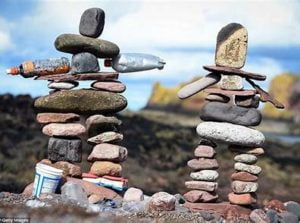
Authored by Melanie Radzicki McManus
If you’ve been out on a hiking trail lately, you’ve probably noticed them suddenly popping up everywhere – small, intentionally stacked piles of rocks, called cairns. And environmentalists worldwide are increasingly alarmed. Because moving rocks can have numerous unintended consequences for insects, animals and even the land.
People have been stacking rocks since the dawn of time, typically for directional or burial purposes. More recently, park officials began creating them on hiking trails – especially potentially confusing paths – to help ensure hikers don’t get lost.

In 1896, a man named Waldron Bates created a specific style of hiking cairn in Acadia National Park. The Bates cairns, as they became known, consisted of a rectangular stone balanced atop two legs, then topped with one stone pointing to the trail. These cairns were replaced by standard ones in the 1950s and 1960s. But the park began rebuilding the historic Bates cairns in the 1990s. Acadia now contains a mixture of both.
What’s concerning scientists today is the new practice of creating rock piles as an art form, or for alluring social media posts. For stacking rocks is not an innocuous practice. Many insects and mammals head under rocks to live, reproduce or escape their predators. So move a rock, and you might destroy a home. Stack a few, and you may have just exposed the hunted to their hunters.

And while it may sound melodramatic, whether you’re stacking rocks in the woods, on the beach or in the desert, your actions could inadvertently knock out an entire colony. Or, in the worst-case scenario, threaten an endangered species.
Some rock-stacking fans note they’re being responsible by returning rocks to the spots where they found them after creating, then disassembling, their artwork. However, the minute you move rocks, you may compromise a species’ habitat in an unrecoverable manner. In addition, moving rocks in any fashion contributes to soil erosion, as the dirt once protectively tucked under them is now prone to washing away.
Should you come upon stacked rocks, especially in national parks, leave them alone. And if you’re hiking, don’t automatically follow them. The National Park Service recommends checking with park officials before setting out on a hike, as every park has different rules about cairns. You don’t want to remove those intentionally set as navigational aids, nor do you want to follow those that may have been randomly assembled by visitors.
In the end, let your actions be guided by this important principle: Leave no trace.

Disclaimer: We at Prepare for Change (PFC) bring you information that is not offered by the mainstream news, and therefore may seem controversial. The opinions, views, statements, and/or information we present are not necessarily promoted, endorsed, espoused, or agreed to by Prepare for Change, its leadership Council, members, those who work with PFC, or those who read its content. However, they are hopefully provocative. Please use discernment! Use logical thinking, your own intuition and your own connection with Source, Spirit and Natural Laws to help you determine what is true and what is not. By sharing information and seeding dialogue, it is our goal to raise consciousness and awareness of higher truths to free us from enslavement of the matrix in this material realm.
 EN
EN FR
FR



























Beautiful pictures, I’m not interested in scientifically proven wrong action in this building of rock formations. I’m always enjoying them as beautiful signs of human presence and a wordless message. They bring a smile on my face and a giggle often too.
These creations are works of art and they’re practical also, as a warning of danger, or as a wayshower. They’re present much in Britain, with that much rock, especially on Dartmoor and in Cornwall, the coast. Not to forget Ireland!
The Netherlands are the bottom of the sea, clay. Only the hunebeds in the county of Drenthe, plus a few huge boulders in some places where the ice-sheet pushed them long ago, originating from nature knows where from! We build garden structures from bricks!
Cyndie seems to condem rock stacking with the outcome of complete insect distruction.
Tibetans have been doing this for thousands of years。